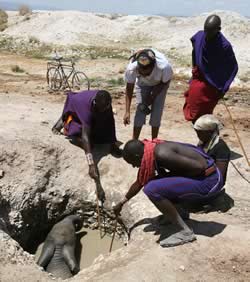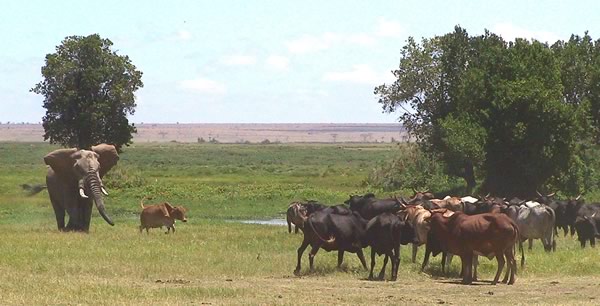|
Exploding human populations, rising consumption of natural resources and the expansion of human activities into previously remote areas is continuing to deplete and further fragment traditional elephant habitat, causing conflict and loss of life. Practical solutions and imaginative new ideas are needed if we are to make a difference. Even more important we, human beings, must begin to curb our excesses and live in balance with available natural resources, if we want to safe-guard ecosystems for elephants, other species, and ultimately, for ourselves. The increasing conflict between elephants and people has two faces. People endure loss of life and property and elephants suffer injuries and mortalities. Just as in negotiating between warring human societies, promoting co-existence between two species requires an understanding of the needs of the protagonists. Over the years numerous projects has been launched to find ways to create more harmony between elephants and people - Save the Elephants Human-Elephant Coexistence Toolbox represents one major, evidence-based initiative. Poor land use and exploding human populationsConservationists, wildlife managers and funding agencies have tended to focus on mitigating the symptoms of human-elephant conflict, through erecting barriers, developing deterrents and early warning systems, and sensitising local communities, rather than managing or eliminating the conflict's ultimate causes. The root causes of the growing conflict between elephants and people are exploding human populations and poor land use planning - politically challenging topics that few are willing to confront. |

Read the 2009 story about a calf that got stuck in a human made well here, and a follow-up story with video of Kibo at Sheldricks orphanage in Nairobi a year later. Since 2013 Kibo has been doing well in Tsavo, Kenya, living wild as all elephants should be allowed to. |
 The resulting unsustainable use of natural resources means the rapid loss and fragmentation of habitat and often, as a result, the cultivation of nutritious crops adjacent to small pockets of elephant habitat. As elephants run out of space, it is little wonder that they turn to cultivation, rich in calories and in easily harvestable clusters. Such elephant delights are especially difficult for risk-taking and fast-growing males to avoid - their size, strength and intelligence making them a most unwanted visitor among numerous communities and villagers across Africa.
The resulting unsustainable use of natural resources means the rapid loss and fragmentation of habitat and often, as a result, the cultivation of nutritious crops adjacent to small pockets of elephant habitat. As elephants run out of space, it is little wonder that they turn to cultivation, rich in calories and in easily harvestable clusters. Such elephant delights are especially difficult for risk-taking and fast-growing males to avoid - their size, strength and intelligence making them a most unwanted visitor among numerous communities and villagers across Africa.
If you in March 2023 searched for "human-elephant conflict" on Google you got 14,900,000 results - just one indication of the competition for resources between elephants and us human beings. If you instead searched for "human-elephant conflict solutions" you may have seen 6,570,000 results (344,000 in Nov. 2016), while a search on "human-elephant co-existence" left you with something like 14,800,000 results (799,000 in Nov. 2018). "human-elephant conflict mitigation" triggers 1,520,000 returns (350,000 in Nov. 2018), of them 1,360 scolarly articles (625 in Nov. 2018). Many of the numerous links listed through these latter searches may be a source of inspiration for those that in different ways are trying to contribute toward the co-existence between people and elephants.
Urgent need for more harmonious co-existence
We must urgently develop and implement land use that takes account of the collective needs of elephants and people if we are reduce long-term conflict and promote more harmonious co-existence. This means that we must stop the indiscriminant destruction of forests, prevent the haphazard development of human settlements, stop the construction of roads and railways in elephant habitat, as well as the depletion of natural water sources. Ultimately, we need to get a grip on our population growth because, never mind the elephants, our very survival depends on it. Taking action to limit the world's human population could help to avoid a human (and habitat) catastrophe. Not taking action now is a violation of our children's and our grandchildren's human rights. Loss of elephant populations will also be disastrous for biodiversity and tourism revenue, and therefore for people, in most elephant range states affected.
ElephantVoices standpoint is that the root cause of conflict is not elephants, but increasing human populations and, lack of holistic land use planning and unsustainable consumption of the planet's natural resources. We must collectively take urgent action to curb our excessive lifestyles, aim for zero population growth, set aside and protect habitat for other species and live in balance with available natural resources.


